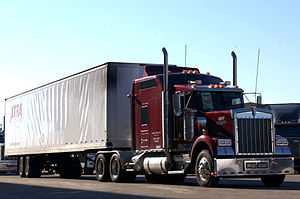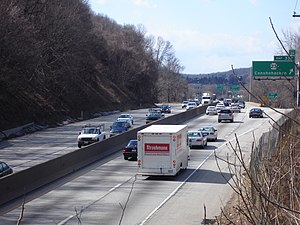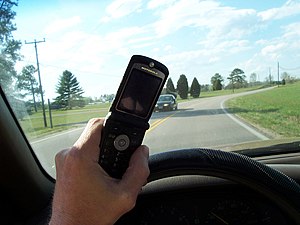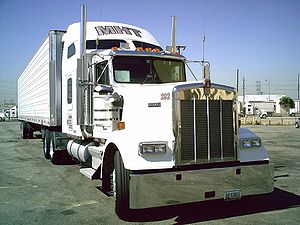 Image via WikipediaFrom: http://www.24-7pressrelease.com/press-release/electronic-logbooks-for-truckers-are-good-but-mandate-brings-problems-179720.php
Image via WikipediaFrom: http://www.24-7pressrelease.com/press-release/electronic-logbooks-for-truckers-are-good-but-mandate-brings-problems-179720.php For years, truckers have tried to make light of their efforts to stay awake while hauling those heavy loads on such tight schedules.
Dave Dudley's 1963 hit, "Six Days On The Road," is one example. The song mentions truck drivers using amphetamines to stay awake ("I'm taking little white pills and my eyes are open wide") and falsifying load limits and log books ("I'm a little overweight and my log book's way behind").
Truck drivers are human and there's no need to demonize them. But ultimately, the fatigue drivers suffer can cause terrible truck accidents with serious and often deadly injuries.
Hours-of-Service Requirements
Because of the importance of keeping truckers well-rested and alert, U.S. law dictates certain "hours-of-service" requirements that prevent commercial truck drivers from being on the road after a certain number of hours. The laws also specify that the driver must have 10 hours of off-duty time before driving again.
Since the 1930s, truckers have been required to account for their time on the road in paper logbooks. In the 1990s, electronic logbooks were introduced, which carry numerous safety advantages.
A bill recently introduced in the Senate would require all truckers to convert to these paperless logs (known as EOBRs, or Electronic On-Board Recorders). This would seem to be a very good thing, at first glance. But the bill also includes dangerous language that could make the nation's highways much less safe.
How Truckers Use Logs
So how is it that electronic logs aid in safety, but the new bill requiring them raises serious safety concerns? To answer this, it's important to understand how logging currently works.
Truckers using paper logs record the time they spend on-duty, driving, sleeping, and off-duty in a logbook, and then send in copies of the log to their trucking company. The company uses the information to pay them based on miles traveled. Because drivers are paid by the mile, it's an open secret that drivers often "fudge" the numbers a little to reflect maximum distance traveled in the shortest time possible. This allows them to claim they had the full 10 hours of rest required by law, when in fact they may have been on duty much longer, and delayed by traffic, equipment problems, or bad weather.
In the late 1990s, one of America's largest trucking companies, Werner Enterprises, developed a paperless log system that works with GPS technology to precisely locate exactly where the truck is at all times. This ensured that all Werner drivers weren't falsifying their records, and allowed their dispatchers to better plan their driver's next assignments, based on their location and availability. Werner worked with the U.S. Department of Transportation (DOT) on the project and became the first company certified to move to a paperless log system.
Today many of the larger trucking companies use EOBR systems. Government research shows these paperless logs are much safer. Companies who have been found in violation of the hours-of-service rules ten percent of the time have a crash rate that is 40 percent higher than the general trucking population. Because of this, the DOT requires companies who have been found in violation more than 10 percent of the time to switch to electronic logs, which are much more difficult for the driver to falsify.
Mandating Electronic Records
Clearly, then, there are well-documented advantages to having only well-rested truckers get behind the wheel. In October, legislation was introduced in the Senate to require all motor carriers to install EOBRs. The bill, called the "Commercial Driver Compliance Improvement Act," would take effect in about three years.
The problem with the legislation, co-sponsored by Tennessee's Lamar Alexander, is that it specifically does not allow the log book information to be used by any party other than the trucking company. Today, when accidents happen on America's highways, the driver's logs are often critical windows into the driver's condition at the time of the accident. Often drivers at fault in a crash have been shown to have falsified their log books. The falsification often comes out after a thorough post-crash examination of their various gas and meal receipts, cell phone records, and other information.
Read more at the link above. t











![Reblog this post [with Zemanta]](http://img.zemanta.com/reblog_e.png?x-id=bbcda0b0-d844-4e39-a4ef-a30e69a69827)

![Reblog this post [with Zemanta]](http://img.zemanta.com/reblog_e.png?x-id=5f79f375-6d42-4d79-aad2-87e7980458c5)

![Reblog this post [with Zemanta]](http://img.zemanta.com/reblog_e.png?x-id=5a487bad-f25b-45be-9464-2d02294155d6)

![Reblog this post [with Zemanta]](http://img.zemanta.com/reblog_e.png?x-id=f98bf6b4-b4b9-4ac1-a88b-4935eb67430c)

![Reblog this post [with Zemanta]](http://img.zemanta.com/reblog_e.png?x-id=aae47ade-c849-442c-8e26-492e094d775e)

![Reblog this post [with Zemanta]](http://img.zemanta.com/reblog_e.png?x-id=1e09dd55-f3e7-41cf-9419-603be20c4933)

![Reblog this post [with Zemanta]](http://img.zemanta.com/reblog_e.png?x-id=282dc5ba-9464-4630-98be-e0f50467363d)

![Reblog this post [with Zemanta]](http://img.zemanta.com/reblog_e.png?x-id=5df0506e-ed42-4726-962e-03a6b89d24be)
![Reblog this post [with Zemanta]](http://img.zemanta.com/reblog_e.png?x-id=506913f2-5944-4f2c-9ace-fd29489d8c18)

![Reblog this post [with Zemanta]](http://img.zemanta.com/reblog_e.png?x-id=0d5367c4-3739-4bd5-964b-02c7b05bb975)

![Reblog this post [with Zemanta]](http://img.zemanta.com/reblog_e.png?x-id=7f001b12-fad0-4039-840f-23d81c375fdf)
![Reblog this post [with Zemanta]](http://img.zemanta.com/reblog_e.png?x-id=128fd0f4-b634-48c2-a678-7472c15ee4d5)
![Reblog this post [with Zemanta]](http://img.zemanta.com/reblog_e.png?x-id=09b83d20-fd85-413c-bdbd-fcc8360f7ea0)
![Reblog this post [with Zemanta]](http://img.zemanta.com/reblog_e.png?x-id=db64c9a1-d1ec-4aba-923a-5820309a6124)

![Reblog this post [with Zemanta]](http://img.zemanta.com/reblog_e.png?x-id=74597886-def7-4395-995c-bb56a2aeff64)
![Reblog this post [with Zemanta]](http://img.zemanta.com/reblog_e.png?x-id=19852b7c-7609-4e48-b483-95ee88b03dbb)